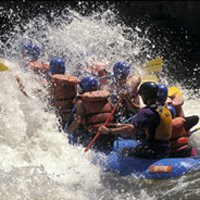- Rapids are the result of the vertical descent of a body of water over a given horizontal distance. Water travels downhill. As obvious as that sounds, you'd be amazed at how many truly clueless people - not yourself, of course - live under the misconception that water travels from north to south, regardless of geography or topography, until it meets an ocean.
- While all rivers have some downhill gradient, steeper gradients result in more rapidly moving water. Rapids, or whitewater, arise as a result of steeply descending river channels.
- Some of the most famous river rapids in the country include the Snake River and Colorado River (through the Grand Canyon). But there are thousands of rivers in every state that offer whitewater rafting trips.
- Since these channels are still being carved by erosion, whitewater rafters have been known to encounter numerous boulders and layers of hard bedrock that sit in the river's path. You know what that means? Fun stuff like vortices of swirling or funneled water, natural ramps, and sudden drops in elevation. Real adrenaline pumpers.
- Rapids are generally classified on a scale of 1-5. The idea is to find a happy medium. Class 1 rapids are just a bit more exciting than a calm river (think water park tameness), while Class 5 rapids are likely to give you heart palpitations.
While there are rivers in the U.S. that are considered Class 6, you will have a very difficult time finding an outfitter that offers expeditions on them, due to the extreme danger involved.
If you're über-adventurous, the Blue Nile River in Africa has rapids that are classified from 1 to 10. In addition to being even more dangerous than a U.S. Class 6, this mighty river has the added challenges of African crocodiles, sleeping death (due to tsetse flies), malaria, and roaming machete-wielding bandits. We recommend you steer clear of these crazy rivers, especially on your first couple of times out. Typically, a good course for beginners mixes Class 1, 2 and 3 rapids. To find almost any level of rapid classification on any river, check out the American Whitewater Association or GORP.com.
